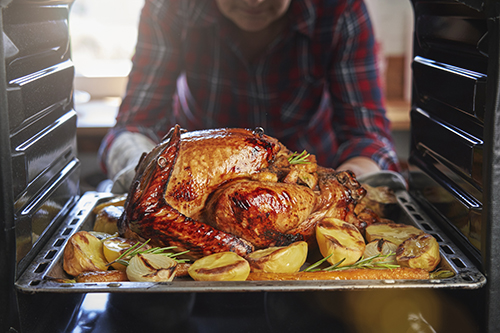10 Tips for Preparing Your Thanksgiving Bird
Nov 14, 2022

There’s a lot of preparation that goes into preparing a turkey complete with crispy skin, tender meat, and a savory flavor. After all, the stakes are high when the main entrée is involved!
Whether you are hosting your first Thanksgiving dinner or your fiftieth, try these 10 tried-and-true tips for cooking a turkey so delicious you won’t want to wait another year to eat it again.
We want to ensure you have a fun, safe, and relaxing holiday. Whether you need a meat thermometer for your turkey, a blower to knock the leaves off your sidewalk, or some camo gear for the hunt you planned right after the meal, your local Co-op has you covered!
For more content like this, check out the latest issue of The Cooperator.
Whether you are hosting your first Thanksgiving dinner or your fiftieth, try these 10 tried-and-true tips for cooking a turkey so delicious you won’t want to wait another year to eat it again.
- Move the oven rack — If you are baking or roasting your turkey, adjust the oven rack so that the center of the bird is in the center of the oven. This will ensure even cooking throughout the meat.
- Dry the surface — Excess moisture will create steam in the oven, resulting in a soggy turkey. Before roasting or seasoning, pat the surface of the turkey dry with paper towels to achieve crispy skin on your bird.
- Roast the turkey on vegetables — Place vegetables such as carrots, celery, and onion in the bottom of a roasting pan and lay your turkey on top. The vegetables will allow heat to penetrate underneath the turkey and aid in even cooking.
- Roast the legs first — Place your turkey in the oven legs first to achieve the perfect texture and flavor. Oven temperatures are often warmer near the back, so the thighs will get the higher heat they need, while the breast will cook in the lower heat by the door.
- Season under the skin — For an extra boost of flavor, lift the turkey skin and rub the seasonings directly onto the meat. Then, lay the skin back down and coat it with an additional layer of seasonings and butter.
- Pin the skin — Use toothpicks to secure the skin to the meat underneath or to pin the skin closed over the cavity. This will keep the skin from shrinking back in the oven and drying out the meat.
- Add a glaze — To get an even, rich brown color without overcooking, use a basting brush to spread molasses, honey, or jam onto lighter areas of the meat to speed up browning.
- Use a thermometer — Where you insert the thermometer into the turkey will determine whether you get an accurate reading or not. Stick the thermometer into the thickest part of the thigh where the breast begins. If it hits the bone you will get an inaccurate reading, so start over. When it reads 165°F, your turkey is ready.
- Keep your stuffing separate — Putting stuffing inside the turkey means it will take longer to finish cooking, thereby increasing the likelihood that your turkey comes out overcooked while your stuffing is undercooked. Instead, just cook the stuffing separately.
- Let it rest — Don’t serve the turkey immediately after taking it out of the oven. Let it finish cooking the last few degrees while resting on your counter so that it doesn’t lose any more moisture in the oven. This will also allow the juices to seep back into the meat, so they aren’t lost to the cutting board.
We want to ensure you have a fun, safe, and relaxing holiday. Whether you need a meat thermometer for your turkey, a blower to knock the leaves off your sidewalk, or some camo gear for the hunt you planned right after the meal, your local Co-op has you covered!
For more content like this, check out the latest issue of The Cooperator.